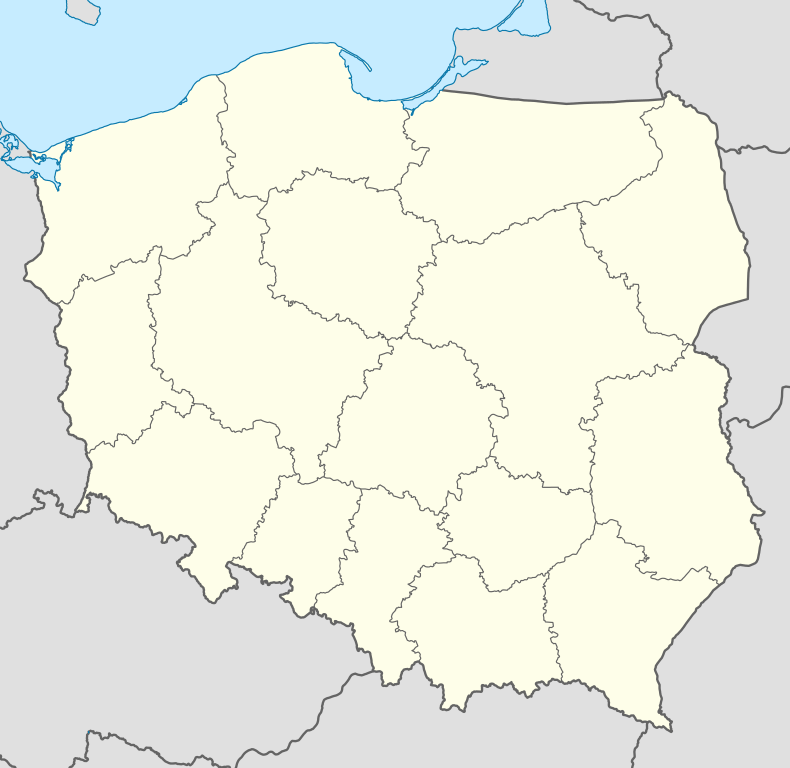Kowalewo Pomorskie
| Kowalewo Pomorskie | ||
|---|---|---|
| ||
 Kowalewo Pomorskie | ||
| Coordinates: 53°10′N 18°54′E / 53.167°N 18.900°E | ||
| Country |
| |
| Voivodeship | Kuyavian-Pomeranian | |
| County | Golub-Dobrzyń | |
| Gmina | Kowalewo Pomorskie | |
| Established | 13th century | |
| Town rights | 1275 | |
| Government | ||
| • Mayor | Andrzej Grabowski | |
| Area | ||
| • Total | 4.45 km2 (1.72 sq mi) | |
| Population (2006) | ||
| • Total | 4,055 | |
| • Density | 910/km2 (2,400/sq mi) | |
| Time zone | CET (UTC+1) | |
| • Summer (DST) | CEST (UTC+2) | |
| Postal code | 87-410 | |
| Area code(s) | +48 56 | |
| Car plates | CGD | |
| Website | http://www.kowalewopomorskie.pl/ | |
Kowalewo Pomorskie [kɔvaˈlɛvɔ pɔˈmɔrskʲɛ] (German: Schönsee (Kreis Briesen)) is a town in Golub-Dobrzyń County, Kuyavian-Pomeranian Voivodeship, Poland. It is the capital of the Gmina Kowalewo Pomorskie. From 1975–1998 the city belonged to the Torun Voivodeship.
According to data from December 31, 2004, Kowalewo Pomorskie has 4130 inhabitants.
History
Kowalewo means (place) of the Smith. The city of Kowalewo was arranged into a rectangular shape. In the times of the Teutonic Knights, Kowalewo and Komturstwo had a separate coat of arms. The coat of arms of their commander was two red fish on a white background. This arm was carried into battle by Nicholas von Viltz who died in battle.
In the beginning the city's commander was Rudolph Kowalewo, and he led 1,000 citizens. Kowalewo was a city in Royal Prussia. In 1455, King Casimir Jagiello (1440–1492) appointed the city's foreman, Gabriela Bazynski. Later, when viovode Chelminski was in power, Jan Plemieki, a courtier of the king, was made foreman of Kowalewo Castle. All that remains of this castle today is a tower which is in ruins.
The Church of St Nicholas and St Ann was established in Kowalewo in 1670. The voivode was Jan Dzialynski. From 1626–1629, the Swedes came to Kowalewo, and on February 11, 1629, Field Marshal Wrangel conquered and plundered Kowalewo. From 1655–1657, the Swedes occupied the city again. They left Kowalewo in near ruins and there were more Prussian and Swedish wars which continued for eighteen years. They were followed by the Saxons and Russians.
There were a series of civil wars during the reign of Augustus II the Strong of Saxony (r. 1697–1704)(r. 1709–1733) and Stanisław Leszczyński (r. 1704–1709) (r. 1733–1736). On October 5, 1716, under Leszczynski's reign was a significant battle. The Russians took what was left of Kowalewo's supplies. They had 1,000 citizens and 120 homesteads before these wars, and by 1772 had only 300 citizens and 34 homesteads.
On September 16, 1772, the foreman of Kowalewo's voivode of Chelminski (Chelmo - German name is Kulm), Frances Stanislas Czapski signed an oath to the Prussian king, Frederick II (1740–1786), "The Great." Kowalewo was broken up and all its lands lay empty and unworked. The town was becoming Germanized as colonists came to build new homesteads, with Prussia's help. All former governments were replaced and were now part of the Regentschaft Marienwerde.
The new government had admired the Polish shoemakers, blacksmiths, bricklayers, and carpenters of Kowalewo. Then a municipal brewery was established by a cooperation of twelve (12) families.
Many Polish were required to join the Prussian military by Frederic II. Many ran away (deserted) from their compulsory service in the army. Those who were caught had their ears cut off and their land taken from them. Kowalewo's taxes rose to twenty five percent (25%) of the inhabitant's wages.
From 1806–1807, Prussian King Frederick William III (1797–1840), son of Frederick William II, allied himself with Russia against France and Napoleon. Prussia lost two battles and the French occupied Berlin while Frederic William III escaped to Konigsburg. Polish General Dabrowski's commanders, a Major Dziewanowski of Vain and Anthony Kruszynski of Nawry, occupied Kowalewo on December 5, 1806, to protect the citizens. In 1807, the Duchy of Warsaw was set up by Napoleon. When peace came in, Tilsit was part of the Varsovian Principality and Torun. On September 10, 1811, the schools, in Kowalewo were inspected by the Management of Public Education in Warsaw.
The Russian army came to Kowalewo (in 1813) in preparation to defeat Napoleon (in 1815). Prussian armies also ran through Kowalewo. More colonists came and made all their Catholic schools Lutheran.
In 1864, there was a January uprising under the leadership of a Kowalewo farmer called Wojciech Falarski. He and his followers were defeated and put into the army. Falarski fought in Denmark, Austria, and France. He returned home after seven years. Falarski lived to age 94.
In 1883, there was a voluntary fire brigade in Kowalevo, and in 1873, Kowalewo had its first bank. For forty years (1883–1873) Kowalewo lost its rights and laws. The Catholic Church helped its people through religious support, patriotism, and cultural support.
After 1873:
- In 1882 - sugar factories were developed in Kowalewo.
- 1884 - Kazimierz Sypniewski was born, in Kowalewo, Poland, on March 8, 1884.
- In 1892 - Kowalewo had a city slaughter-house.
- In 1896 - a creamery was established, based on a farmer's cooperative creamery.
- In 1898 - gas works were built.
- In 1899 - the first telephones and railway lines were being established.
The railway line was to go from Bromberg-Brodnic. - November 1, 1900 the rail line is open for business.
In 1900, the Kowalewo Sypniewski family emigrates to the United States of America, and are first found in the 1920 census in Glassport, Pennsylvania. - In 1911, waterworks were built.
Coordinates: 53°09′N 18°54′E / 53.150°N 18.900°E
References
| ||||||||||||
